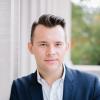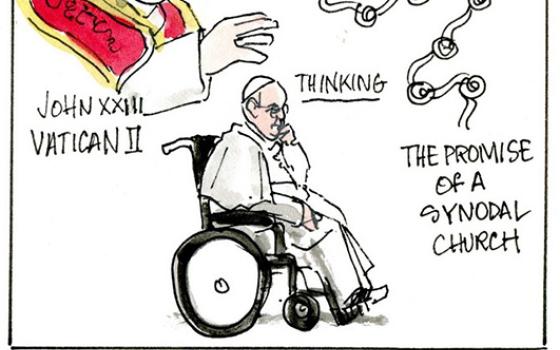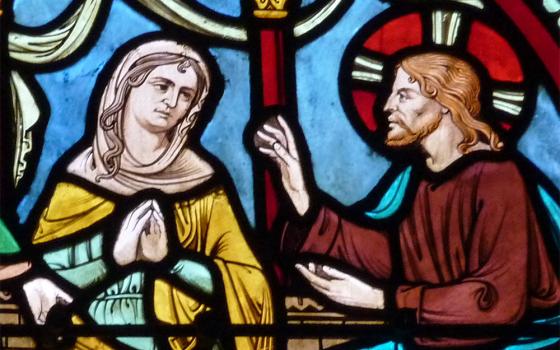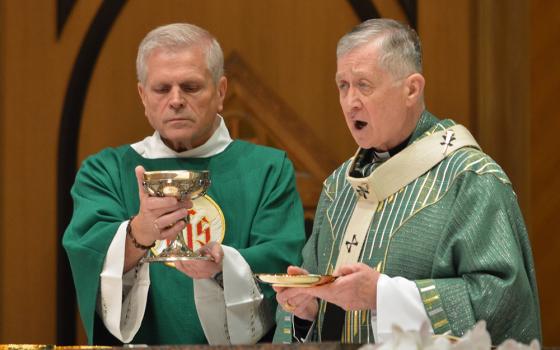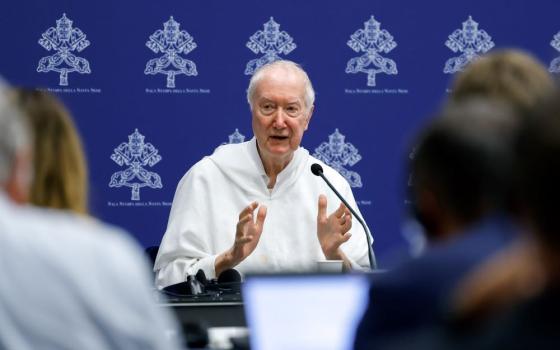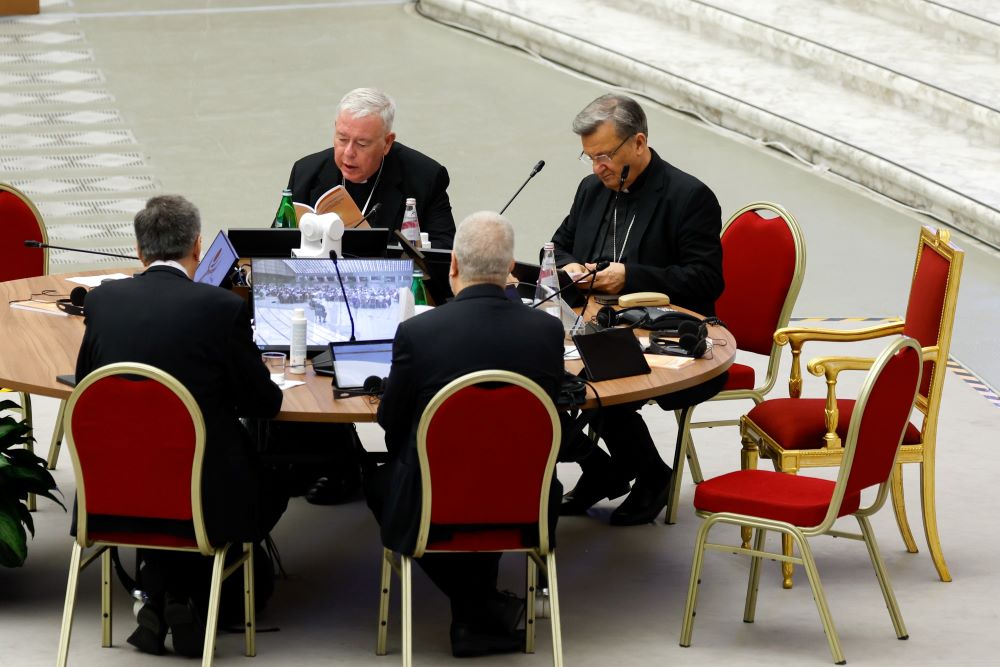
Cardinal Jean-Claude Hollerich, relator general of the synod, and Cardinal Mario Grech, synod secretary-general, pray in the Vatican's Paul VI Audience Hall at the start of a working session of the Synod of Bishops Oct. 10. (CNS/Lola Gomez)
In a 2014 "60 Minutes" interview, Boston Cardinal Sean O'Malley defended the Catholic Church's ban against the ordination of women, saying that "If I were founding a church, I'd love to have women priests. But Christ founded it, and what he has given us is something different."
During the first week of Pope Francis' monthlong summit on the future of the Catholic Church, O'Malley is seated at the same roundtable as Swiss delegate Helena Jeppesen-Spuhler, who has made it clear that she supports women's ordination.
In an interview prior to the start of this Synod of Bishops, Jeppesen-Spuhler said that part of synodality and the journey to become a more listening and participatory church requires openly acknowledging disagreements among Catholics.
In many ways, the story of Francis' Synod on Synodality is best told through such images, rather than words.
In fact, it's actually one of the only ways it can be told, thanks to the pope's request that delegates refrain from speaking to the media in hopes that the synod does not become a debate about only a few select issues, or a place where certain personalities dominate the spotlight.
Advertisement
Delegates sit at roundtables as a reminder that "none of us is a star in this synod," said one of its chief organizers, Luxembourg Cardinal Jean-Claude Hollerich, at the opening session on Oct. 4.
Journalists are allowed into the Vatican's Pope Paul VI hall each day to observe morning prayer and we can view a livestream of the opening presentations of the five modules, or themes, that set the stage for small group discussions. Once the cameras are switched off, the discernment begins.
Even so, these limited moments provide snapshots of what the synod is aiming to accomplish — but also its challenges.
Xavière Sr. Nathalie Becquart, a Number 2 official at the Vatican's synod office, was seated at the pope's own roundtable during the first session. British theologian Anna Rowlands kicked off this week's discussions with a theological reflection on the theme of "communion."
"I'm experiencing and witnessing the dismantling of the hierarchical," Mercy Sr. Angela Perez, of Guam told my Global Sisters Report colleague Rhina Guidos as she reflected on these novelties during the opening days of the synod.
Other images tell different stories.
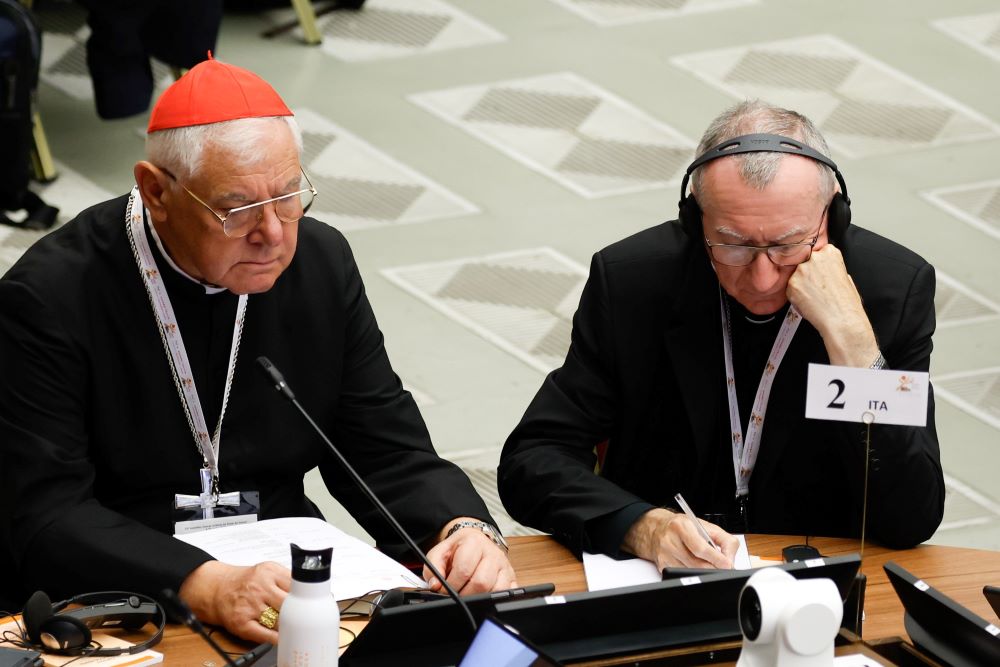
Cardinal Gerhard Müller, left, is the only cardinal at the synod who wears a formal cassock and red zucchetto, despite the relaxed dress code. He is pictured at a synod session in the Vatican's Paul VI Audience Hall Oct. 9. (CNS/Lola Gomez)
From the balcony overlooking the synod hall where reporters get a bird's-eye view of morning prayer, German Cardinal Gerhard Müller is always the easiest to spot. A noted synod skeptic who has warned that what is taking place is a "hostile takeover" of the church, Müller is the only cardinal who continued to wear a formal cassock and his cardinal's red zucchetto, despite the relaxed dress code for participants. (Most bishops are wearing the less formal suit jacket and collared shirt).
Müller, who has expressed wariness over the inclusion of lay members in the synod process — 54 of whom are women — is sharing his roundtable this week with Adorer of the Blood of Christ Sr. Nadia Coppa, a cheerleader of the pope's decision to finally extend voting rights to laity.
At another table sits the Vatican's foreign minister, Archbishop Paul Gallagher, and Bishop Daniel Flores of Brownsville, Texas, who as both a prelate on the U.S.-Mexico border and as the chairman of the U.S. bishops' doctrinal committee, is sort of a diplomat himself.
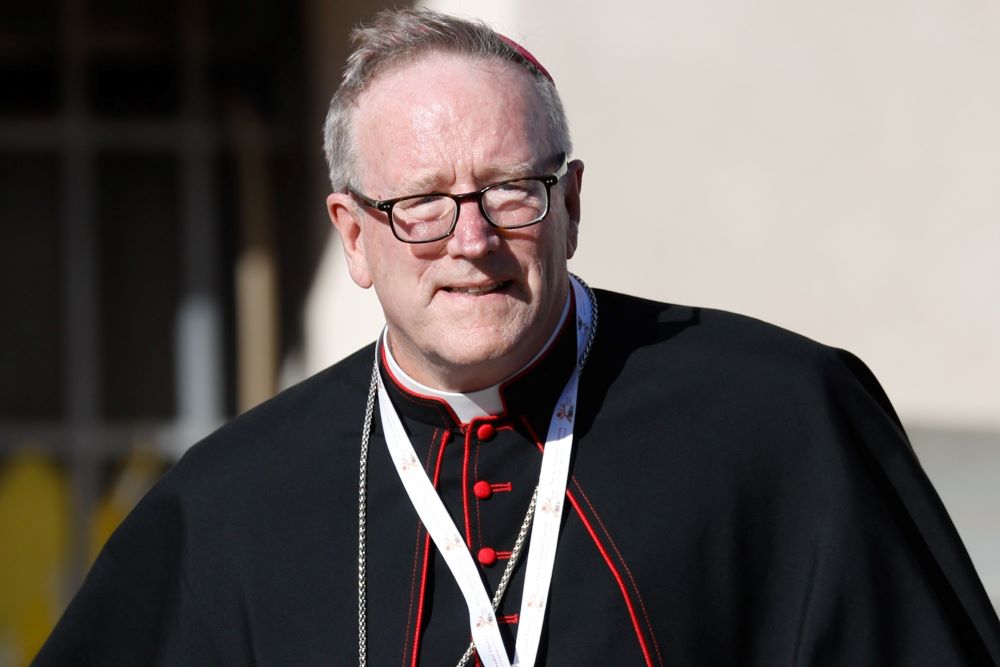
Bishop Robert E. Barron of Winona-Rochester, Minn., arrives for the first working session of the assembly of the Synod of Bishops at the Vatican Oct. 4. During one live streamed session, his name appeared on the screen, the feed showed Our Lady of Apostles Sr. Mary Teresa Barron instead. (CNS/Lola Gomez)
But perhaps one of the more amusing and memorable scenes of this meeting to date came in its opening hours, as recounted to NCR by multiple synod members.
One new feature of the synod has been the introduction of tablets and cameras at each roundtable. When synod delegates want to speak during open floor discussions, they put their names on a list, and then are given three minutes at the mic to speak about an issue that concerns them.
In one session, due to a technical glitch, the name that popped up on the list was that of Bishop Robert Barron of the Diocese of Winona-Rochester, Minnesota, who prior to the synod had conveyed his concerns about how the synod might address questions regarding women and LGBTQ persons.
But when the live feed began of the individual due to speak it showed Our Lady of Apostles Sr. Mary Teresa Barron.
She went on to deliver a markedly different address from what many delegates were expecting from the media-guru turned bishop who happens to share her surname.
To quote Francis, when he opened the synod in 2021: "the Holy Spirit always surprises us."
